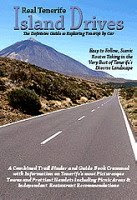 We’d been toying with the idea of joining one of the pilgrimages to Candelaria to honour the Canary Island’s patron saint, the black virgin, at the weekend. In the end we bottled it and decided to drive instead.
We’d been toying with the idea of joining one of the pilgrimages to Candelaria to honour the Canary Island’s patron saint, the black virgin, at the weekend. In the end we bottled it and decided to drive instead.When you go to a lot of fiestas on Tenerife, you learn to spot signs that ultimately will save you time in the long run. The first on Friday of last week was the queue of traffic at the Punta Larga end of Candelaria. This is the opposite end of town from where the celebrations were taking place, but if the Canarios were leaving the motorway at this point, it meant the other junction was going to be a nightmare. We were incredibly lucky with parking and found what seemed to be the last legitimate spot in the whole of the town. I say legitimate because once the parking spaces are all gone, the Canarios employ a bit of ingenuity. Zebra crossings are next option to park, then it’s the pavements, the tiniest square of waste ground… wherever there’s the slightest hint of a space.
Two things took us by surprise in Candelaria on Friday night. The first was that the town looked quite attractive by dark. We’d only ever visited Candelaria in the day time before and whilst the area around the Basilica is quite quaint and the Mencey statues are impressive, much of the town is semi high-rise and bland. At night the less appealing parts are disguised by the darkness, so the rather smart promenade lined with tempting looking restaurants becomes the focus and it looks like a pleasant place to spend a bit of time.
The second surprise was that the party wasn’t just taking place around the Basilica. The promenade between the Basilica and the marina was filled with food stalls, an ethnic market, fairground attractions and an agricultural market. Bunting added colour to the pretty plaza and the Basilica, lit up splendidly, looked much older and grander than its relatively young 50 years (and I mean this as a compliment).
The main event of the evening was the re-enactment of the discovery of the Virgen de Candelaria by a pair of Guanche shepherds who would have to climb a couple of steps on the intellectual ladder to reach ‘Dumb and Dumber’ status.
Not only are they spectacularly stupid (they couldn’t tell the difference between a real woman and baby and a wooden one), they’re also a bit cowardly as is the rest of their tribe, if the re-enactment is to be believed anyway.
 Fancy a whole gang of strapping men with spears being scared off by a woman holding a baby? I’ve probably just committed Canarian blasphemy there – still as long as I carry a wooden image of a woman holding a baby I should apparently be able to fend off any number of people who want to take issue (think crucifixes and vampires here).
Fancy a whole gang of strapping men with spears being scared off by a woman holding a baby? I’ve probably just committed Canarian blasphemy there – still as long as I carry a wooden image of a woman holding a baby I should apparently be able to fend off any number of people who want to take issue (think crucifixes and vampires here).I wonder what the noble Menceys who stand erect and proud on the seaward side of the plaza would think of the buffoonery which is played out before them. Still, it’s all good fun, especially if you park the rational section of your brain at the same time as you park the car.
As the night progressed the town became busier and busier and the Basilica looked spectacular periodically lit up by the ubiquitous firework displays. However, the image which will remain etched in my brain was the sight of thousands upon thousands of pilgrims of all ages carrying wooden staffs streaming into Candelaria from all corners of the island. Many looked shattered and on their last legs, but all were laughing and beaming from ear to ear at finally reaching their destination.
I might gently mock the re-enactment, but the devotion displayed by the pilgrims is something completely different, something which shows how important being Canario is to them. To witness it was quite an experience.
See More Virgen de Candelaria Photographs Here







